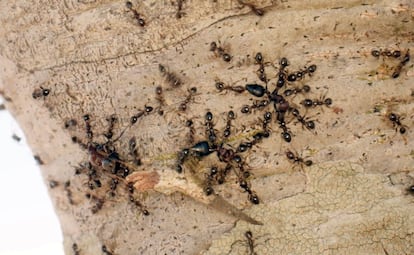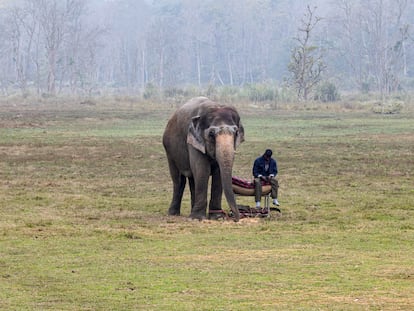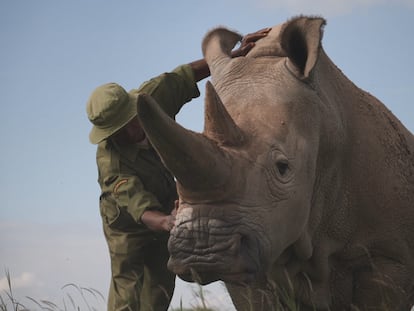The ants that defeated the lions
An invasive species of the insects caused a chain reaction in the savanna that left the big cats unable to hunt zebras
This is an ensemble film in which ants protect trees from huge elephants and receive shelter in return. In the shade of whistling thorns (a kind of acacia tree), the lions stalked zebras, their favorite prey, which meant that they did not need to attack the imposing buffaloes, which lived peacefully in this part of the African savanna. But a few years ago, another species of ants called lion ants arrived in Kenya’s Ol Pejeta reserve and turned the whole ecosystem upside down. After the new arrivals exterminated the native ants, the acacias were left without their protectors, the pachyderms destroyed them, and the big cats lost the parapet from which to ambush zebras, which they can no longer hunt. Ultimately, in this story, the losers are not so much the kings of the jungle as the buffaloes, which have come to represent almost half of the lions’ diet.
The whistling thorn (Acacia drepanolobium) is a myrmecophyte plant, meaning that it is associated with a colony of ants, in this case Crematogaster mimosae. The symbiotic relationship between acacias and insects is what ecologists call foundational mutualism, because they are at the base of the entire ecosystem. The trees have evolved by developing specific organs where the insects build their nests. They also exude nectar from their flowers for their guests. In return, the ants fiercely defend them from elephants, which make up 70% of the park’s megaherbivores. Their weapons? Their jaws and the formic acid they shoot into the elephants’ trunks, which are very sensitive, as well as into their mouths and eyes. Despite the unevenness of the battle, the defense works, as the images before and after the invasion show.
These acacias, the base of the ecosystem, are also key to its apex. The savanna is a frightening landscape in which the game of life and death, of predators and prey, depends on visibility. In Ol Pejeta Park (famous for being home to the last two northern white rhinos and the scene of their attempted recovery), lions take advantage of the whistling thorn to stalk zebras, which seek as much open space as possible. Equids accounted for two-thirds of the felids’ diet until the lion ants came along.
“We started spotting them around 2014, but they had been there for a while, maybe over a decade. They’re very small, so they can go unnoticed if you’re not looking for them,” says Todd Palmer, an ecologist at the University of Florida and the senior author of this study. Palmer has been working at Ol Pejeta since the turn of the century and has published several papers on the mutually beneficial relationship between acacias and their ants. His concern grew as he watched lion ants (Pheidole megacephala) take over one acacia after another. These ants are among the 100 most harmful invasive species on the planet. And they have a well-earned reputation. When they arrive on a whistling thorn, they kill rivals and eat their eggs, pupae and larvae, wiping out the anthill, even though they are much smaller than C. mimosae. “When they first appeared, none of us noticed because they are not aggressive with large animals, including people. Now we see that they are transforming landscapes in very subtle ways, but with devastating effects,” Palmer adds.
Once the defenders are exterminated, the lion ants bore holes in the ground under the acacia trees where they create their nest and ignore the fate of the tree, which is left defenseless from elephants. The enormous herbivores are not restrained; without formic acid and stings to prevent it, they do not limit themselves to leaving the tree without leaves, they destroy it. The consequence is that, over the last decade, the landscape has been cleared. Ecologists knew that this would have consequences at the highest level of the food chain. To investigate this, they fenced off several plots of land with electrified wire fences in both invaded and invasive-free areas and tracked the movements of six GPS-collared lionesses belonging to prides with a population of over 80 big cats. For three years, scientists analyzed their movements and the number of prey animals they hunted.
The results, now published in the academic journal Science, show the chain reaction that a tiny animal of barely 2 millimeters can cause (that is the workers’ size; the soldiers reach up to 12 millimeters), capable of forcing the king of the jungle to change the prey on which it feeds. In the unfenced plots that have invasive ants, many of the acacias have disappeared and visibility has almost tripled. Unlike in other ecosystems, Ol Pejeta’s lions do not chase after their prey. They stalk and ambush it by taking advantage of the distortion of the scenery caused by tree trunks and foliage. But without the trees, the occurrence of zebras taken in the ant-invaded areas was almost three times lower than in areas that were still free of the pest. Since 2003, the proportion of zebras in the feline diet in the park has dropped from 67% to 42%. However, the lion population has not declined. The explanation seems to be buffalo. Twenty years ago, before the arrival of the lion ants, lions did not hunt a single buffalo. Now, they represent 42% of their diet.

“Nature is smart and creatures like lions tend to find solutions to the problems they face,” Palmer recounts, “but we don’t yet know what will happen after this profound change in their hunting strategy; we want to know how this story ends.” Lion ants are moving through Ol Pejeta at a rate of 50 meters (3.3 feet) a year. At the other end of the ecosystem, the savanna’s top predator has been forced to switch prey. In a post, Palmer reminds us that “buffalo are very large, with males that are twice as big as the largest zebra, and both males and females have horns that they can use to defend themselves, so they will always be formidable prey; for now, whether lions will be able to keep hunting more buffalo without suffering the consequences is an unanswered question.”
The end of this story has yet to be decided. The invasion of lion ants, inadvertently introduced from the Indian islands by humans, is a growing phenomenon throughout East Africa, a vast region of hundreds of thousands of square kilometers where 70%-90% of the vegetation cover is acacia species like whistling thorn. We do not know what the consequences might be if what is happening in Ol Pejeta is also happening in other parks and reserves. In a commentary on the study, also published in Science, zoologist Kaitlyn M. Gaynor of the University of British Columbia in Canada writes, “Ultimately, conserving healthy ecosystems requires not only preventing species extinctions, but also identifying and preserving the most important interactions between species,” such as that of the whistling thorn and its protective ants.
You can follow us on Facebook, X and Instagram, or sign up here to receive our weekly newsletter.
Tu suscripción se está usando en otro dispositivo
¿Quieres añadir otro usuario a tu suscripción?
Si continúas leyendo en este dispositivo, no se podrá leer en el otro.
FlechaTu suscripción se está usando en otro dispositivo y solo puedes acceder a EL PAÍS desde un dispositivo a la vez.
Si quieres compartir tu cuenta, cambia tu suscripción a la modalidad Premium, así podrás añadir otro usuario. Cada uno accederá con su propia cuenta de email, lo que os permitirá personalizar vuestra experiencia en EL PAÍS.
¿Tienes una suscripción de empresa? Accede aquí para contratar más cuentas.
En el caso de no saber quién está usando tu cuenta, te recomendamos cambiar tu contraseña aquí.
Si decides continuar compartiendo tu cuenta, este mensaje se mostrará en tu dispositivo y en el de la otra persona que está usando tu cuenta de forma indefinida, afectando a tu experiencia de lectura. Puedes consultar aquí los términos y condiciones de la suscripción digital.
More information
Archived In
Últimas noticias
Aquilino Gonell, former Capitol sergeant: ‘If it hadn’t been for the police, the US would be a dictatorship’
A hybrid building: Soccer pitch, housing, and a shopping mall
Europe urges Trump to respect Greenland following annexation threats
Science seeks keys to human longevity in the genetic mixing of Brazilian supercentenarians
Most viewed
- Alain Aspect, Nobel laureate in physics: ‘Einstein was so smart that he would have had to recognize quantum entanglement’
- Mexico’s missing people crisis casts a shadow over World Cup venue
- Why oil has been at the center of Venezuela-US conflicts for decades
- Alvin Hellerstein, a 92-year-old judge appointed by Bill Clinton, to preside over Maduro’s trial in New York
- Cuba confirms death of 32 of its citizens in the US attack against Venezuela











































